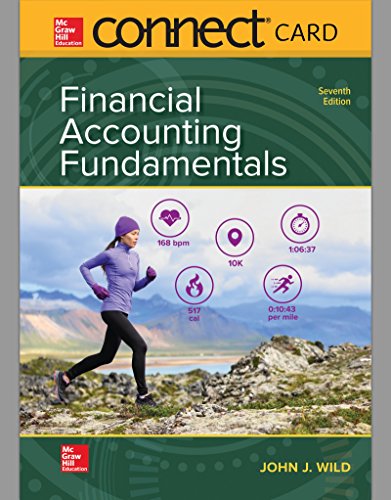
1.
Ascertain the percent of the original cost of Company A’s property and equipment that remains to be
1.
Explanation of Solution
The percent of the original cost of property and equipment that remains to be depreciated is calculated by taking the ratio between the book value of the property and equipment and their original costs.
Compute the percent of original cost of property and equipment that remains to be depreciated as on September 26, 2015.
Compute the percent of original cost of property and equipment that remains to be depreciated as on September 27, 2014.
Hence, the percent of the original cost of Company A’s property and equipment that remains to be depreciated as of September 26, 2015, and September 27, 2014 are 45.6% and 52.9%, respectively.
2.
Identify the length of time over which Company A is depreciating its major categories of buildings and equipment.
2.
Explanation of Solution
Identify the length of time over which Company A is depreciating its major categories of buildings and equipment as follows:
According to Note 1: “Property, Plant and Equipment” of the annual report, the estimated lives of major asset category are as follows:
- Building and improvements – 30 years or the remaining life of the building
- Machinery and equipment – 1 to 5 years
3.
Ascertain the change in total property, plant, and equipment for the year ended September 26, 2015, and the amount of cash provided by investing activities for property and equipment for the year ended September 26, 2015 and also discuss the one possible explanation for the difference between these two amounts.
3.
Explanation of Solution
Ascertain the change in total property, plant, and equipment for the year ended September 26, 2015 as follows:
Hence, the change in total property, plant, and equipment for the year ended September 26, 2015 is $10,242 million.
The amount of cash provided by investing activities for property and equipment for the year ended September 26, 2015 is $11,247 million.
One possible explanation for the difference between these two amounts is that Company A has disposed property and equipment during the year. The property and equipment could have been scrapped for no proceeds as the investing section of the
The other possible explanation is that Company A has written off the fully depreciated assets, and it has acquired property and equipment for something, that is, other than cash.
4.
Compute Company A’s total asset turnover for the year ended September 26, 2015 and the year ended September 27, 2014.
4.
Explanation of Solution
Compute Company A’s total asset turnover for the year ended September 26, 2015.
Compute Company A’s total asset turnover for the year ended September 27, 2014.
Hence, Company A’s total asset turnover for the year ended September 26, 2015 and the year ended September 27, 2014are 0.89 times and 0.83 times, respectively.
5.
Recompute Company A’s total asset turnover for the additional year and comment on any differences relative to the turnover computed in part 4.
5.
Explanation of Solution
Compute Company A’s total asset turnover for the year ended September 24, 2016.
Company A’s total asset turnover for the year ended September 26, 2015, September 27, 2014, and September 24, 2016 are 0.89 times, 0.83 times, and 0.70 times, respectively. Hence, it can be concluded that the total asset turnover computed for the year ended September 24, 2016 has decreased when compared to the years 2014 and 2015.
Want to see more full solutions like this?
Chapter 8 Solutions
Connect Access Card For Financial Accounting Fundamentals
- What is independence of the audit?arrow_forwardBruno Manufacturing uses direct labor-hours in its predetermined overhead rate. At the beginning of the year, the total estimated manufacturing overhead was $680,000. At the end of the year, actual direct labor-hours for the year were 42,500 hours, manufacturing overhead for the year was underapplied by $25,500, and the actual manufacturing overhead was $695,000. The predetermined overhead rate for the year must have been closest to: A) $16.00 B) $15.75 C) $16.35 D) $16.94arrow_forwardWhat was manufactured overhead?arrow_forward
- Which of the following choices is the correct status of manufacturing overhead at year-end?arrow_forwardMorris Corporation applies manufacturing overhead at the rate of $40 per machine hour. Budgeted machine hours for the current period were anticipated to be 200,000; however, higher than expected production resulted in actual machine hours worked of 225,000. Budgeted and actual manufacturing overhead figures for the year were $8,000,000 and $8,750,000, respectively. On the basis of this information, the company's year-end overhead was: A. overapplied by $250,000 B. underapplied by $250,000 C. overapplied by $750,000 D. underapplied by $750,000arrow_forwardAt the beginning of the year, manufacturing overhead for the year was estimated to be $560,000. At the end of the year, actual labor hours for the year were 35,000 hours, the actual manufacturing overhead for the year was $590,000, and the manufacturing overhead for the year was underapplied by $30,000. If the predetermined overhead rate is based on direct labor hours, then the estimated labor hours at the beginning of the year used in the predetermined overhead rate must have been ___ hours.arrow_forward

 AccountingAccountingISBN:9781337272094Author:WARREN, Carl S., Reeve, James M., Duchac, Jonathan E.Publisher:Cengage Learning,
AccountingAccountingISBN:9781337272094Author:WARREN, Carl S., Reeve, James M., Duchac, Jonathan E.Publisher:Cengage Learning, Accounting Information SystemsAccountingISBN:9781337619202Author:Hall, James A.Publisher:Cengage Learning,
Accounting Information SystemsAccountingISBN:9781337619202Author:Hall, James A.Publisher:Cengage Learning, Horngren's Cost Accounting: A Managerial Emphasis...AccountingISBN:9780134475585Author:Srikant M. Datar, Madhav V. RajanPublisher:PEARSON
Horngren's Cost Accounting: A Managerial Emphasis...AccountingISBN:9780134475585Author:Srikant M. Datar, Madhav V. RajanPublisher:PEARSON Intermediate AccountingAccountingISBN:9781259722660Author:J. David Spiceland, Mark W. Nelson, Wayne M ThomasPublisher:McGraw-Hill Education
Intermediate AccountingAccountingISBN:9781259722660Author:J. David Spiceland, Mark W. Nelson, Wayne M ThomasPublisher:McGraw-Hill Education Financial and Managerial AccountingAccountingISBN:9781259726705Author:John J Wild, Ken W. Shaw, Barbara Chiappetta Fundamental Accounting PrinciplesPublisher:McGraw-Hill Education
Financial and Managerial AccountingAccountingISBN:9781259726705Author:John J Wild, Ken W. Shaw, Barbara Chiappetta Fundamental Accounting PrinciplesPublisher:McGraw-Hill Education





